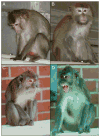Behavioral and neurobiological characteristics of social stress versus depression in nonhuman primates
- PMID: 21983263
- PMCID: PMC4031682
- DOI: 10.1016/j.expneurol.2011.09.026
Behavioral and neurobiological characteristics of social stress versus depression in nonhuman primates
Abstract
The focus of the review is on the behavioral and physiological manifestations of stress versus depression. The purpose of the review is to evaluate the conceptual approach of using stress models as surrogates for depression. Social stress and depression have many characteristics in common and promote each other. Both have adverse effects on social relationships and the quality of life, and increase risk of other diseases. However, they are not the same constructs. In human and nonhuman primates, the behavior and neurobiology of stressed individuals differ from that of depressed individuals. Some similarities in stress physiology in socially stressed and depressed individuals have been used to support the use of stressed animals as models of depression, and much has been learned from stress models of depression. However, the studies reviewed here also suggest that the depressed state also has different characteristics than the stressed state, and studying the differences may be important to furthering our understanding of each of these constructs as well as their mutual relationship.
Copyright © 2011. Published by Elsevier Inc.
Figures

Similar articles
-
Modeling depression in adult female cynomolgus monkeys (Macaca fascicularis).Am J Primatol. 2012 Jun;74(6):528-42. doi: 10.1002/ajp.21013. Epub 2011 Nov 10. Am J Primatol. 2012. PMID: 22076882 Review.
-
Behavioral responses to social stress in noradrenaline transporter knockout mice: effects on social behavior and depression.Brain Res Bull. 2002 Jul;58(3):279-84. doi: 10.1016/s0361-9230(02)00789-x. Brain Res Bull. 2002. PMID: 12128153
-
Neurobiology of early life stress: nonhuman primate models.Semin Clin Neuropsychiatry. 2002 Apr;7(2):96-103. doi: 10.1053/scnp.2002.31784. Semin Clin Neuropsychiatry. 2002. PMID: 11953933 Review.
-
Early experience and depressive disorders: human and non-human primate studies.J Affect Disord. 2003 Jul;75(2):97-113. doi: 10.1016/s0165-0327(03)00046-6. J Affect Disord. 2003. PMID: 12798250 Review.
-
Models for the experimental analysis of depression.Acta Psychiatr Belg. 1986;86:733-47. Acta Psychiatr Belg. 1986. PMID: 2882646
Cited by
-
Functional differentiation of adult-born neurons along the septotemporal axis of the dentate gyrus.Cold Spring Harb Perspect Biol. 2015 Aug 3;7(8):a018978. doi: 10.1101/cshperspect.a018978. Cold Spring Harb Perspect Biol. 2015. PMID: 26238355 Free PMC article. Review.
-
The influence of social environment on endocrine, cardiovascular and tissue responses in the rabbit.Int J Psychophysiol. 2013 Jun;88(3):282-8. doi: 10.1016/j.ijpsycho.2012.04.008. Epub 2012 Apr 27. Int J Psychophysiol. 2013. PMID: 22546665 Free PMC article.
-
Serotonergic, brain volume and attentional correlates of trait anxiety in primates.Neuropsychopharmacology. 2015 May;40(6):1395-404. doi: 10.1038/npp.2014.324. Epub 2014 Dec 11. Neuropsychopharmacology. 2015. PMID: 25586542 Free PMC article.
-
What is animal happiness?Ann N Y Acad Sci. 2019 Feb;1438(1):62-76. doi: 10.1111/nyas.13983. Epub 2018 Oct 22. Ann N Y Acad Sci. 2019. PMID: 30345570 Free PMC article. Review.
-
Birth origin differentially affects depressive-like behaviours: are captive-born cynomolgus monkeys more vulnerable to depression than their wild-born counterparts?PLoS One. 2013 Jul 4;8(7):e67711. doi: 10.1371/journal.pone.0067711. Print 2013. PLoS One. 2013. PMID: 23861787 Free PMC article.
References
-
- Abbott DH, Keverne EB, Bercovitch FB, Shively CA, Mendoza SP, Saltzman W, Snowdon CT, Ziegler TE, Banjevic M, Garland T, Jr, Sapolsky RM. Are subordinates always stressed? A comparative analysis of rank differences in cortisol levels among primates. Horm Behav. 2003;43 (1):67–82. - PubMed
-
- Adler NE. Health disparities through a psychological lens. Am Psychol. 2009;64:663–673. - PubMed
-
- Adler NE, Rehkopf DH. U.S. disparities in health: descriptions, causes, and mechanisms. Annu Rev Public Health. 2008;29:235–252. - PubMed
-
- Adler NE, Boyce T, Chesney MA, Cohen S, Folkman S, Kahn RL, Syme SL. Socioeconomic status and health. The challenge of the gradient. Am Psychol. 1994;49:15–24. - PubMed
-
- Aguilera M, Arias B, Wichers M, Barrantes-Vidal N, Moya J, Villa H, van Os J, Ibáñez MI, Ruipérez MA, Ortet G, Fañanás L. Early adversity and 5-HTT/BDNF genes: new evidence of gene-environment interactions on depressive symptoms in a general population. Psychol Med. 2009;39 (9):1425–1432. - PubMed
Publication types
MeSH terms
Grants and funding
LinkOut - more resources
Full Text Sources
Medical

